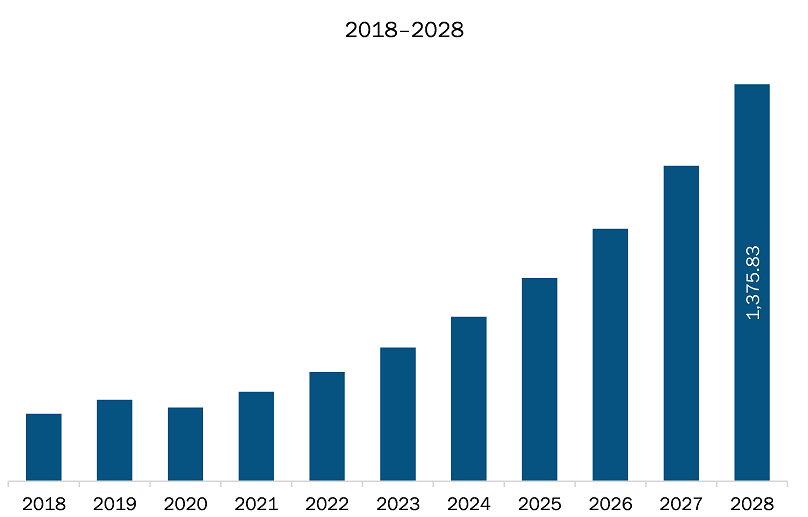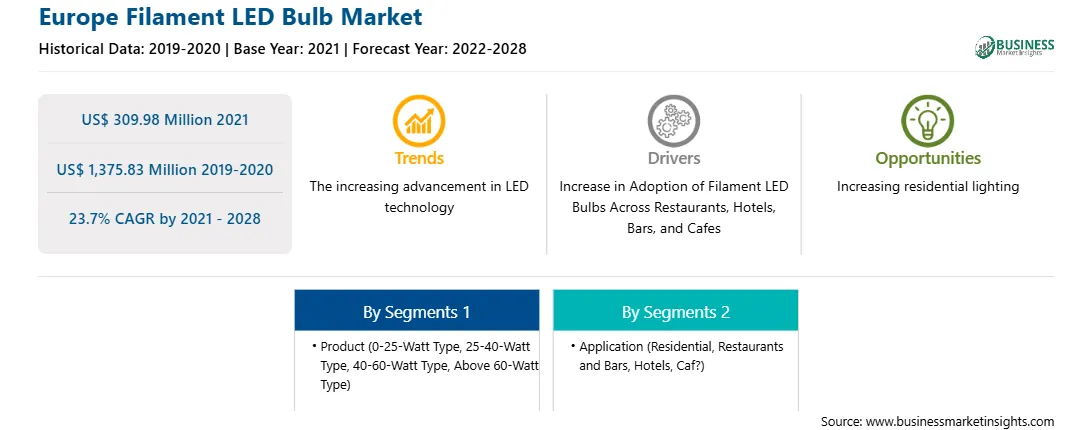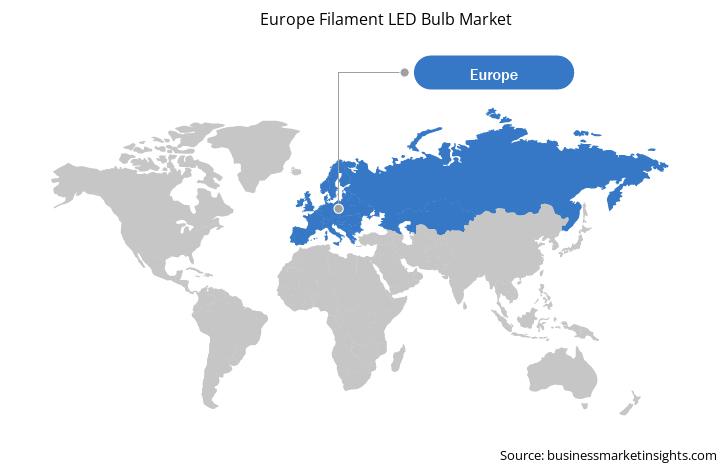The European filament LED bulb market is further segmented into France, Germany, Russia, Italy, the UK, and the Rest of Europe. Europe is a diverse market with a group of more than 40 countries in it. The Western European countries are more advanced than the Nordic and Eastern European countries, which is a key factor contributing to the high adoption of advanced lighting systems across both commercial and residential complexes. Economically strong countries such as Germany, Italy, the UK, and Spain have been significantly implementing these bulbs over the years. Following a period of stagnation in recent years, the European construction sector has recently soared. The residential sector is rising due to demographic changes, increase in per capita income, and cheap mortgage rates. These reasons are propelling the European market for the residential development. The demand for creative lighting systems is expected to expand quicker as the number of individual households, opulent dwellings, and multi-residential properties increases. The tendency is expected to continue in the upcoming years, as the population of European countries continues to rise, resulting in a large amount of available land for residential building. The construction sector in European countries such as Germany and the UK is booming. Various governments throughout the world are launching programs to help the construction industry. The increased development of residential and commercial structures is expected to give lucrative opportunities for the filament LED bulb market to expand in the region.
Due to the COVID-19 outbreak, Russia, UK, France, Italy, Spain, and Germany are some of the worst affected member states in the European region. Businesses in the region face severe economic difficulties as they had to suspend their operations or substantially reduce their activities. Due to business lockdowns, travel bans, and supply chain disruptions, the region experienced an economic slowdown in 2020 and, most likely, in 2021. European countries represent a major market for filament LED bulb adoption due to low energy consumption of the bulbs. Since several European countries are in the phase of lockdowns, the adoption of the filament LED bulbs got hampered. Covid-19 first manifested itself in Europe as a “supply-side” shock, as Chinese producers cut their exports dramatically. This impact is expected to continue in the coming weeks. However, following an extraordinary downturn in March and April (-25.5 percent in the EU), construction output rose dynamically in May 2020 (21.8 percent) and continued to rise, though at a slower pace; by January 2021, construction output had recovered 97.9 percent of its pre-crisis level of February 2020. Russia, Italy, Germany, UK, and France filament LED bulb markets are anticipated to decrease until mid-2021

Strategic insights for the Europe Filament LED Bulb provides data-driven analysis of the industry landscape, including current trends, key players, and regional nuances. These insights offer actionable recommendations, enabling readers to differentiate themselves from competitors by identifying untapped segments or developing unique value propositions. Leveraging data analytics, these insights help industry players anticipate the market shifts, whether investors, manufacturers, or other stakeholders. A future-oriented perspective is essential, helping stakeholders anticipate market shifts and position themselves for long-term success in this dynamic region. Ultimately, effective strategic insights empower readers to make informed decisions that drive profitability and achieve their business objectives within the market.

| Report Attribute | Details |
|---|---|
| Market size in 2021 | US$ 309.98 Million |
| Market Size by 2028 | US$ 1,375.83 Million |
| Global CAGR (2021 - 2028) | 23.7% |
| Historical Data | 2019-2020 |
| Forecast period | 2022-2028 |
| Segments Covered |
By Product
|
| Regions and Countries Covered | Europe
|
| Market leaders and key company profiles |
The geographic scope of the Europe Filament LED Bulb refers to the specific areas in which a business operates and competes. Understanding local distinctions, such as diverse consumer preferences (e.g., demand for specific plug types or battery backup durations), varying economic conditions, and regulatory environments, is crucial for tailoring strategies to specific markets. Businesses can expand their reach by identifying underserved areas or adapting their offerings to meet local demands. A clear market focus allows for more effective resource allocation, targeted marketing campaigns, and better positioning against local competitors, ultimately driving growth in those targeted areas.

The filament LED bulb market in Europe is expected to grow from US$ 309.98 million in 2021 to US$ 1,375.83 million by 2028; it is estimated to grow at a CAGR of 23.7% from 2021-2028. Growth in adoption of filament LED bulbs across restaurants, hotels, bars, and cafes; the lighting at a restaurant is an important aspect of the overall design. Cafes and restaurants should incorporate lighting into their architectural plans as well. Lighting solutions are as important as the food and service is the environment of the café and restaurant. In cafes, bars, and restaurants, light intensity of 150 lux is generally recommended. Among other areas, entrances require 100 lux, food storage section requires 150 lux, washing section needs 300 lux, and cooking section requires 500 lux. Restaurants use four types of lighting: general lighting, accent lighting, decorative lighting, and natural lighting. In a cafe or restaurant, general lighting is the most significant feature. Homogeneous lighting is achieved by placing lighting equipment in a certain order at equal intervals. Customers will perceive the restaurant as more welcoming if it has decent overall illumination. Accent lighting can be utilized to draw focus to the areas of the restaurant that one wishes to draw attention to. This type of lighting can draw attention to the restaurant's decor, plants, tables, or merchandise. Decorative lighting refers to the lighting accessories that are employed to complete the design. Both traditional and modern lighting can be used to create decorative lighting. It can also be achieved by using specific lighting techniques. Thus, the various lighting techniques used in restaurants, hotels, bars, and cafes are influencing the adoption of filament LED bulbs, thereby contributing to the growth of the market.
In terms of product, 0-25-Watt type segment held the largest share Europe filament LED bulb market in 2020. In terms of application, the
A few major primary and secondary sources referred to for preparing this report on the filament LED bulb market in Europe are company websites, annual reports, financial reports, national government documents, and statistical database, among others. Major companies listed in the report are Havells India Ltd
The Europe Filament LED Bulb Market is valued at US$ 309.98 Million in 2021, it is projected to reach US$ 1,375.83 Million by 2028.
As per our report Europe Filament LED Bulb Market, the market size is valued at US$ 309.98 Million in 2021, projecting it to reach US$ 1,375.83 Million by 2028. This translates to a CAGR of approximately 23.7% during the forecast period.
The Europe Filament LED Bulb Market report typically cover these key segments-
The historic period, base year, and forecast period can vary slightly depending on the specific market research report. However, for the Europe Filament LED Bulb Market report:
The Europe Filament LED Bulb Market is populated by several key players, each contributing to its growth and innovation. Some of the major players include:
The Europe Filament LED Bulb Market report is valuable for diverse stakeholders, including:
Essentially, anyone involved in or considering involvement in the Europe Filament LED Bulb Market value chain can benefit from the information contained in a comprehensive market report.